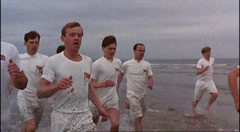
Walks on the beach
Share
The lockdown is over and many people are enjoying the proximity of the sea. A delight.
We see young and old people walking along the sea. Bare feet caressed by the freshness of the clear waters. Wonderful. It's fun, but is it always healthy? Well, sometimes it isn't.

It is not the same for someone who is used to it or regularly does sports and does not find it any additional discomfort, as for someone who leads a sedentary life and whose only physical activity is going to be this walk (worse if he or she is overweight, has osteoarthritis or circulatory problems in the lower limbs, and also does it during the hottest hours, or wants to lose weight in a single day by walking for several hours).
*If you are not used to walking barefoot.
*If walking is similar to walking on a ditch (a plane with a lateral inclination), sinking the heel and requiring greater effort in all phases of the step, or with greater instability if it is drier sand:
This is a very easy way to cause injuries if you don't do it gradually, starting with a few minutes and increasing as tolerated.
Every year, after the summer holidays, many patients (some athletes too) come to the clinic with various pathologies, such as metatarsalgia (foot pain), Achilles tendonitis, Plantar Fasciitis (pain in the plantar area of the heels), etc. and some say... "and that was even though I was walking on the beach", when in many cases that has been the trigger for their injuries.
In some well-controlled situations and in collaboration with physiotherapists, walking on wet or dry sand may be advisable for specific injuries and for a certain period of time.
 The general medical recommendation is to WALK and do so with appropriate footwear, in flat areas and at times when it is not very hot (early morning or late afternoon). If you have not done so before: start with 20-30 minutes and gradually increase the time and pace of the walk. At any age.
The general medical recommendation is to WALK and do so with appropriate footwear, in flat areas and at times when it is not very hot (early morning or late afternoon). If you have not done so before: start with 20-30 minutes and gradually increase the time and pace of the walk. At any age.People with joint problems, overweight, circulatory disorders, also have the option of walking IN the water, if possible submerged up to the neck, to achieve several healthy effects:
* In these conditions, body weight is much lower in the water, which reduces the load on the joints and allows strengthening without overloading. It is more difficult to move in the water, which also improves the effect on the muscles.
* The pressure exerted by water on the body is greater in the feet and decreases as it rises, producing a very beneficial effect on blood circulation (similar to that of variable compression stockings, which are used for external varicose veins).
* Solar radiation is significantly reduced on the trunk and, above all, on the lower limbs, thus avoiding the harmful effect on varicose veins or edema.
Happy summer. Enjoy it.

PS: It is recommended not to run on slopes or inclined surfaces. The characters that appear in the movie "Chariots of Fire" did so on flat ground.

Article written by Juan Serrano Jimenez, Specialist in Traumatology and Orthopedic Surgery
